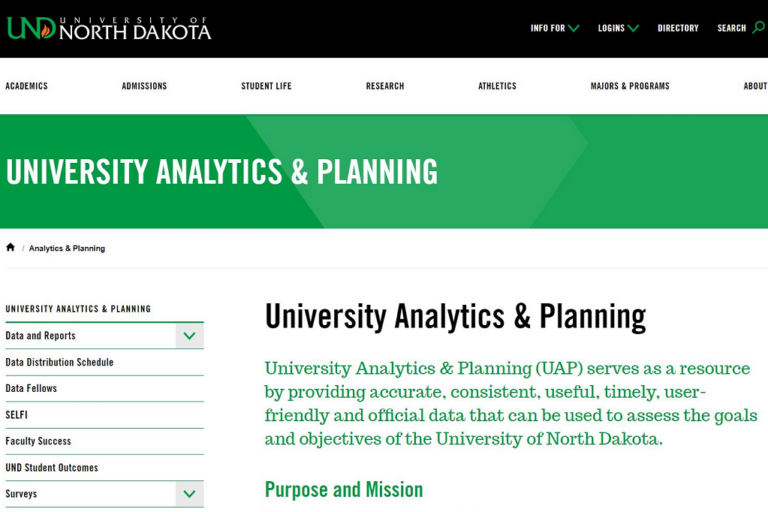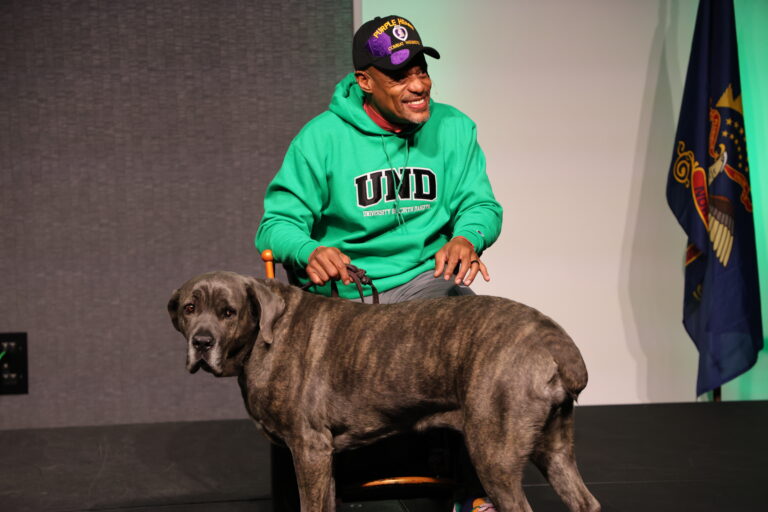First steps: liberal arts and retention
Latest Provost Forum offers updates on UND Strategic Plan Goals No. 1 and 2
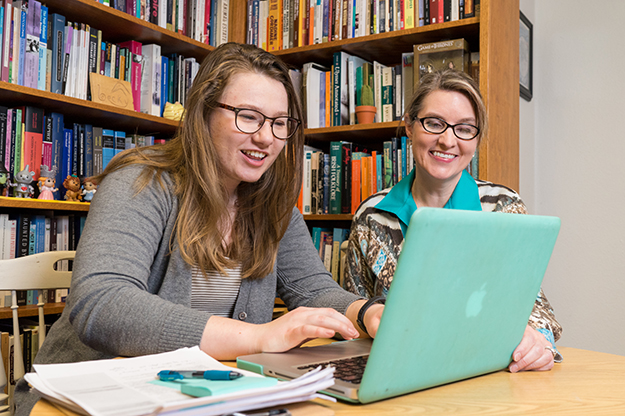
On Oct. 26, UND experienced its first snowy, gusty winter weather system of the season. As those outside battled the bitter cold, friendly competition was heating up the Education Building lecture hall.
Professor Pat O’Neill, associate dean of the College of Business & Public Administration and member of the UND Strategic Plan Goal No. 1 implementation team, sat front row and center, chanting proudly.
“We’re number one! We’re number one!” O’Neill bellowed to the laughs of the crowd. “Bring Debbie up already!”
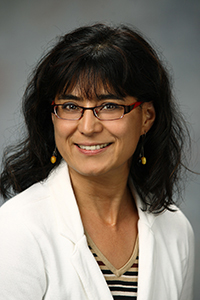
With that rousing introduction, Goal One Captain and Dean of the College of Arts & Sciences Debbie Storrs took the floor for the semester’s third public Provost Forum, this one focusing on the first two goals of the UND Strategic Plan.
Storrs said she was selected to lead the implementation of Goal No. 1 – providing a strong undergraduate liberal arts foundation – because the liberal arts are important to the College of Arts and Sciences. But, she added, they’re important to the entire University and the success of its graduates.
“Employers want the kinds of skills that the liberal arts develop in students … ethical decision making, written communication, critical thinking and teamwork,” Storrs said.
Goal One contains several action items, beginning with measuring the skills and learning outcomes of current UND freshmen and seniors. The implementation team has partnered with the Essential Studies to use the same assessment rubrics. With those assessments, they will compare UND’s learning outcomes with other institutions.
The next step will be tracking and evaluating UND’s high-impact practices (HIPs), known to increase liberal arts skills and retention. Every student will be required to have at least three HIPs during their undergraduate career, such as undergraduate research, internships, or intensive writing courses. Storrs said that although UND already has many of these experiences available, they haven’t been fully identified and measured for quality and equity.
The Goal No. 1 team will also work with departments and colleges to develop academic pathways to encourage students to double major or minor across colleges – creating a greater breadth of knowledge.
“For an aviation major, perhaps a good minor or double major would be English, because they need strong writing skills, or maybe it’s a certificate in diversity or double major in engineering,” Storrs explained.
Storrs urged those in the audience to help the team’s efforts by changing the growing narrative about job readiness that emphasizes only applied professions and professional schools.
“When you’re meeting with parents or students, help them understand the value of the liberal arts,” she implored.
Attention to retention
Storrs passed the ear of the audience to Jen Rogers, project manager for Goal No. 2 (increasing retention and graduation rates).
“Does anyone know what our current four-year undergraduate graduation rate is?” Rogers asked the crowd. After a few guesses, she revealed that it was just 27 percent. “We’re shooting for 34 percent, two percentage points higher than our comparison flagship universities.”
Rogers explained the ways in which her team is collaborating with Strategic Enrollment Management to achieve the nine action steps of Goal Two.
The first to-do is getting campus fully on board with the student success software Starfish, which is noted for increasing retention at other institutions. Secondly, the team will work to standardize the roles and responsibilities of academic advisors campus wide and evaluate their performance.
Goal Two calls for developing a process for outbound calling activities to personally reach out to students who, for example, have holds on their accounts or have missed registration deadlines to make sure they are staying enrolled and on track.
The team is also hoping that the launch of a standard Degree Planner will help students keep their eyes on a diploma. Two degree planner vendors are coming to campus Nov. 7, and Rogers urged the crowd to attend those demonstrations.
Reducing courses with high DWF (D-grade, failure and withdrawal) rates is another objective.
“We want to identify what causes those high rates in those courses, and we’re looking to implement some proactive discussions and requirements for students to take part in prior to withdrawing from a class,” Rogers said.
Further action items of Goal No. 2 include creating pathways and reducing barriers to graduation, optimizing financial aid, establishing a mandatory first-year experience course, and developing graduate enrollment management strategies.
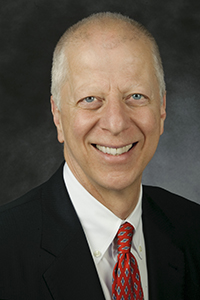
Time & progress
When UND Provost Tom DiLorenzo opened the forum for questions, Biology Professor Bill Sheridan wondered, with new faculty requirements of the Strategic Plan, how faculty could effectively balance teaching and research.
“Faculty are in good spirits to embrace good ideas, but I personally have been experiencing things like Starfish and others that have a lot of merit, but which demand more of my time,” he said.
DiLorenzo replied that new tools like Starfish and the Degree Planner are a part of a paradigm shift in higher education and actually make things easier for faculty.
“Many of the things we’ll be using are tried and true. Research shows that they work, they will save time in the end, and they enfranchise others to help – including staff, advisors and parents,” DiLorenzo said.
Lisa Earls, project manager in the Division of Finance and Operations, inquired about assessing the plan’s progress.
“If we have a five-year plan, when do we start to check in on the effectiveness of the plan?” she asked
“The President plans to have a monthly meeting where the goal captains report out,” DiLorenzo answered. “In the annual evaluations, we’ll be looking at that progress as well. Monthly and annually, we’ll be assessing if we’re moving in the right direction.”

